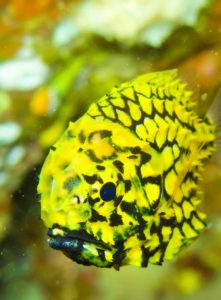Pineapple Under the Sea
The Japanese Pinecone is one of four species of pineapple-looking fish under the Monocentridae family. One could say their features resemble those of a pineapple and their physique, that of a pine cone.
In the same family, one other kind of fish similar to the Japanese Pinecone in appearance is the Pineapple fish — gee, we wonder what it looks like! Also known by its scientific name, Cleidopus gloriamari, the Australian Pineapple fish is the largest in the family, as big as eight inches in total length, according to a 2016 article by PracticalFishkeeping.co.uk.

The Japanese Pinecone fish, just like the Australian Pineapple fish and two other similar kinds of Monocentridae fish, looks awfully like a tiny pineapple swimming under the sea. Its body has a yellow coloring and its scales are outlined in black, giving it the illusion of a pineapple or pine cone. Its body size doesn’t grow over seven inches in total, with most Pinecone fishes usually being only four to five inches in length, as reported by Pascualita Sa-a for FishBase.de.
Thanks to being the tiniest of the bunch, the Japanese Pinecone fish is more or less the “runt of the litter” in the Monocentridae family.
Pineapples that Hang Out
The Japanese Pinecone fish can be found in the sublittoral zone of the ocean (that part where the sunlight can still reach the ocean floor) and they spend the day in caves, in coral reefs, underneath rocks, and in rocky overhangs (Weird Fish of the Week, 2016).
That is all it does during the day – hang out. This nocturnal species tends to just hang around in dark areas in the daytime before venturing out to go and hunt for food. In particular, the Japanese Pinecone fish form predatory schools closer to the bottom of the ocean floor where their diet of smaller fishes and shrimps are more concentrated.
Location-wise, the Japanese Pinecone fish can be found around the Indian and Pacific oceans, as far north as Japan to as far south as Australia and New Zealand. Other species of Pinecone fish can even be found in South Africa.
Other Fish Beware!
Aside from the Pinecone fish’s scutes, its pelvic and dorsal fin spines form part of its armor. These big structures are lockable: they can get stuck in the alimentary system of a bigger fish foolish enough to eat it.
Bright Armor
The Japanese Pinecone fish isn’t hard on the eyes. It is, however, hard on the teeth. The pinecone appearance not only comes from its color but also from the way the scales on its body overlap. It ends up looking like heavy platemail armor.
On its sides are spikes running down the length of its body. The spikes apparently are not just superficial scales, but also form part of its skeleton.
In a 2017 study by Stephanie Pappas of the University of Washington published in LiveScience, a computed tomography scan done on a Pinecone fish showed that the skeleton was actually one big bony armor. The spikes were divided into small sections called scutes.
Glow in the Dark
The Japanese Pinecone Fish supposedly glows: it’s not only the body that makes it luminescent, but also the bacteria!
According to a 2008 article written by Kathryn Snavely for The Gale Encyclopedia of Science, there are two phosphorescent organs on the lower jaw of the Japanese Pinecone Fish that attracts the bacteria, which maintain a symbiotic relationship with their host.
The bioluminescence varies from a yellow tint to a bluish-green color, depending on how much light manages to reach the fish, according to a 2014 article about the pinecone fish in the RW Sentosa Blog.
It still isn’t known exactly what those organs are for but there are several guesses: improving vision, finding prey, or communicating with other marine life.
This appeared in Animal Scene magazine’s September 2018 issue.








